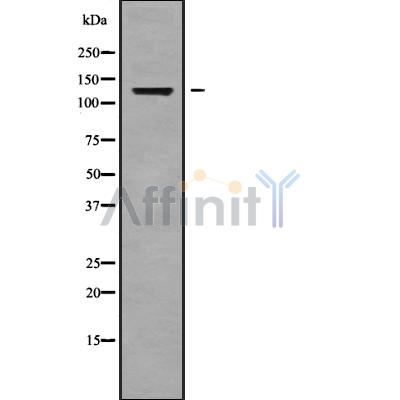ADAMTS14 Antibody - #DF9172
| Product: | ADAMTS14 Antibody |
| Catalog: | DF9172 |
| Description: | Rabbit polyclonal antibody to ADAMTS14 |
| Application: | WB IHC |
| Reactivity: | Human, Mouse, Rat |
| Mol.Wt.: | 134 kDa; 134kD(Calculated). |
| Uniprot: | Q8WXS8 |
| RRID: | AB_2842368 |
Related Downloads
Protocols
Product Info
*The optimal dilutions should be determined by the end user. For optimal experimental results, antibody reuse is not recommended.
*Tips:
WB: For western blot detection of denatured protein samples. IHC: For immunohistochemical detection of paraffin sections (IHC-p) or frozen sections (IHC-f) of tissue samples. IF/ICC: For immunofluorescence detection of cell samples. ELISA(peptide): For ELISA detection of antigenic peptide.
Cite Format: Affinity Biosciences Cat# DF9172, RRID:AB_2842368.
Fold/Unfold
A disintegrin and metalloproteinase with thrombospondin motifs 14; ADAM TS14; ADAMTS 14; ADAMTS14; EC 3.4.24; FLJ32820;
Immunogens
A synthesized peptide derived from human ADAMTS14, corresponding to a region within C-terminal amino acids.
Expressed in retina and at low levels in brain, lung and placenta (PubMed:11779638). High expression in fetal tissues (PubMed:11867212).
- Q8WXS8 ATS14_HUMAN:
- Protein BLAST With
- NCBI/
- ExPASy/
- Uniprot
MAPLRALLSYLLPLHCALCAAAGSRTPELHLSGKLSDYGVTVPCSTDFRGRFLSHVVSGPAAASAGSMVVDTPPTLPRHSSHLRVARSPLHPGGTLWPGRVGRHSLYFNVTVFGKELHLRLRPNRRLVVPGSSVEWQEDFRELFRQPLRQECVYTGGVTGMPGAAVAISNCDGLAGLIRTDSTDFFIEPLERGQQEKEASGRTHVVYRREAVQQEWAEPDGDLHNEAFGLGDLPNLLGLVGDQLGDTERKRRHAKPGSYSIEVLLVVDDSVVRFHGKEHVQNYVLTLMNIVDEIYHDESLGVHINIALVRLIMVGYRQSLSLIERGNPSRSLEQVCRWAHSQQRQDPSHAEHHDHVVFLTRQDFGPSGYAPVTGMCHPLRSCALNHEDGFSSAFVIAHETGHVLGMEHDGQGNGCADETSLGSVMAPLVQAAFHRFHWSRCSKLELSRYLPSYDCLLDDPFDPAWPQPPELPGINYSMDEQCRFDFGSGYQTCLAFRTFEPCKQLWCSHPDNPYFCKTKKGPPLDGTECAPGKWCFKGHCIWKSPEQTYGQDGGWSSWTKFGSCSRSCGGGVRSRSRSCNNPSPAYGGRLCLGPMFEYQVCNSEECPGTYEDFRAQQCAKRNSYYVHQNAKHSWVPYEPDDDAQKCELICQSADTGDVVFMNQVVHDGTRCSYRDPYSVCARGECVPVGCDKEVGSMKADDKCGVCGGDNSHCRTVKGTLGKASKQAGALKLVQIPAGARHIQIEALEKSPHRIVVKNQVTGSFILNPKGKEATSRTFTAMGLEWEDAVEDAKESLKTSGPLPEAIAILALPPTEGGPRSSLAYKYVIHEDLLPLIGSNNVLLEEMDTYEWALKSWAPCSKACGGGIQFTKYGCRRRRDHHMVQRHLCDHKKRPKPIRRRCNQHPCSQPVWVTEEWGACSRSCGKLGVQTRGIQCLLPLSNGTHKVMPAKACAGDRPEARRPCLRVPCPAQWRLGAWSQCSATCGEGIQQRQVVCRTNANSLGHCEGDRPDTVQVCSLPACGGNHQNSTVRADVWELGTPEGQWVPQSEPLHPINKISSTEPCTGDRSVFCQMEVLDRYCSIPGYHRLCCVSCIKKASGPNPGPDPGPTSLPPFSTPGSPLPGPQDPADAAEPPGKPTGSEDHQHGRATQLPGALDTSSPGTQHPFAPETPIPGASWSISPTTPGGLPWGWTQTPTPVPEDKGQPGEDLRHPGTSLPAASPVT
Research Backgrounds
Has aminoprocollagen type I processing activity in the absence of ADAMTS2. Seems to be synthesized as a latent enzyme that requires activation to display aminoprocollagen peptidase activity. Cleaves lysyl oxidase LOX at a site downstream of its propeptide cleavage site to produce a short LOX form.
The precursor is cleaved by a furin endopeptidase.
Glycosylated. Can be O-fucosylated by POFUT2 on a serine or a threonine residue found within the consensus sequence C1-X(2)-(S/T)-C2-G of the TSP type-1 repeat domains where C1 and C2 are the first and second cysteine residue of the repeat, respectively. Fucosylated repeats can then be further glycosylated by the addition of a beta-1,3-glucose residue by the glucosyltransferase, B3GALTL. Fucosylation mediates the efficient secretion of ADAMTS family members. Also can be C-glycosylated with one or two mannose molecules on tryptophan residues within the consensus sequence W-X-X-W of the TPRs, and N-glycosylated. These other glycosylations can also facilitate secretion (By similarity).
Secreted>Extracellular space>Extracellular matrix.
Expressed in retina and at low levels in brain, lung and placenta. High expression in fetal tissues.
The spacer domain and the TSP type-1 domains are important for a tight interaction with the extracellular matrix.
Restrictive clause
Affinity Biosciences tests all products strictly. Citations are provided as a resource for additional applications that have not been validated by Affinity Biosciences. Please choose the appropriate format for each application and consult Materials and Methods sections for additional details about the use of any product in these publications.
For Research Use Only.
Not for use in diagnostic or therapeutic procedures. Not for resale. Not for distribution without written consent. Affinity Biosciences will not be held responsible for patent infringement or other violations that may occur with the use of our products. Affinity Biosciences, Affinity Biosciences Logo and all other trademarks are the property of Affinity Biosciences LTD.
